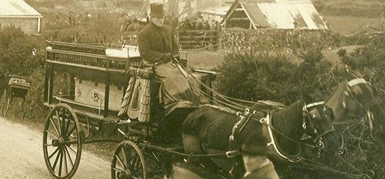
St Agnes historian Clive Benney brings us a macabre, who-dunnit tale from 1920 in the sleepy village of Skinners Bottom.
A hundred years ago a couple were brutally murdered in the garden of their home. Two theories were put forward but what was the jury’s verdict?
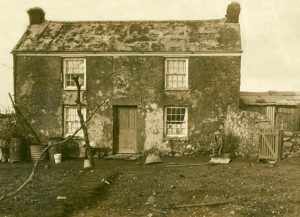 The garden where the bodies were found (Photo: courtesy Clive Benney)
The garden where the bodies were found (Photo: courtesy Clive Benney)
On Sunday 25th January 1920 Joseph Hoare, a cattle and horse dealer aged 57, and his common law wife, Laura Sara aged 45, were bludgeoned to death at their cottage at Skinners Bottom near Blackwater.
At about 9.00am on the morning of the murder Joseph’s friend, Jack Prior, visited the cottage. He looked over the garden wall from the road and saw Laura Sara lying face down. He could hear her breathing and saw her head was bleeding. He shouted to Hoare and getting no reply ran to a neighbouring farm. Later asked by the county coroner, Mr E.L. Carlyon, about why he hadn’t rushed to the woman’s assistance, Pryor explained he was afraid. “What of?” asked the coroner. “I thought Hoare had gone mad and hit her and thought he might do the same to me.” “You have known Hoare many years,” said Mr Carlyon. “Do you think he was a person likely to go mad?” “No,” Pryor admitted.
When Pryor, the neighbour and P.C. Stephens from Blackwater reached the house they found Sara struggling to get up on her hands and knees; she was wearing her nightdress. Hoare was then found lying near a small wicket gate; he was fully dressed and around his neck was a sack which was pulled over his head. Both were still living but had serious head injuries. Hoare and Sara were taken indoors and Doctor Forsyth from Chacewater was sent for but both died before he arrived.
Hoare was a farmer and cattle dealer, while Laura Sara was his housekeeper and lover, separated from her husband for several years. Both were considered to be of loose morals and with a fondness for drink, and she had been convicted of keeping a disorderly house. The murder weapon was assumed to have been a log from the bloodstained pile near the cottage.
The cow shed adjoining the house was spattered with clots of blood and the galvanised iron in the corner was covered with congealed blood. It was assumed that Hoare, after receiving his injuries, tried to reach his house but fell unconscious in the garden. It is thought he went to feed his cattle and when near the door of the shed, was attacked violently. It is then assumed that Laura Sara, hearing Hoare’s cries of help, rushed downstairs in her nightdress and met a similar fate.
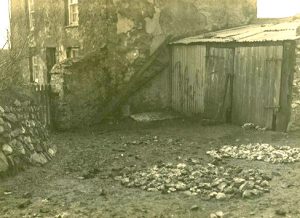 Blood on the wall of the cowshed wall (Photo: courtesy Clive Benney)
Blood on the wall of the cowshed wall (Photo: courtesy Clive Benney)
The house in which the couple lived bore no traces of being ransacked and more than £20 in cash was found so it would seem robbery was not the motive for the crime.
Enquires by the local police started immediately and the assistance of Scotland Yard was called for. Chief Insp. Heldon and Detective Sergeant Canning soon arrived.
 Scotland Yard and Cornwall police at the murder scene (Photo: courtesy Clive Benney)
Scotland Yard and Cornwall police at the murder scene (Photo: courtesy Clive Benney)
On the 27th of January Mr E.L. Carlyon opened the inquest in the vestry of the Wesleyan chapel at Skinners Bottom. The coroner outlined the facts to the jurors and said, “…you will see you must come to one of three conclusions; that it is a case of one of the deceased parties murdered the other and then committed suicide; or there must have been a struggle between them they both dealt each other such injuries that they subsequently died; or the blows must have been inflicted by some third person…” The inquest was adjourned to the 12th of February.
For the next two weeks police enquires continued but with no arrests taking place. Eventually the adjourned inquest took place at Blackwater Men’s Institute with Mr A. J. Whale, the Blackwater School Headmaster, foreman of the jury. All the evidence was presented and witnesses called. Finally, Chief Insp. Heldon put forward his theory that no one else was involved and that Sara had intended to kill Hoare to benefit from his will. She had watched him dress, go downstairs and leave the house to go to the cowshed. He suggested that she followed him down, took the weapon from the kitchen, where similar branches had been cut for firewood, followed him to the cowshed and as Hoare turned towards her, struck him a terrible blow to the forehead. Hoare, after receiving the blow, took the stick and struck her at least two or three times, they then both died from their injuries.
Dr. Forsyth could not agree, describing the man’s wounds he said the man was only struck one blow but that had broken the frontal bone in five pieces, in his opinion it would have been impossible for him to have inflicted the injuries on the woman after receiving his wounds.
Briefly summing up the coroner said it was for the jury to decide who was right, Chief Insp. Heldon or Dr Forsyth.
It took the jury less than half an hour to agree and by a majority of seven out of eight: “a verdict of wilful murder by some person or persons unknown”.
The couple were buried at St Peter’s Church, Mithian. A newspaper report stated: ‘The cortège proceeded to Mithian Churchyard, about a mile and a half away. Hundreds of people followed on foot, and in addition to a number of carriages, there were over thirty jingles and market traps.’
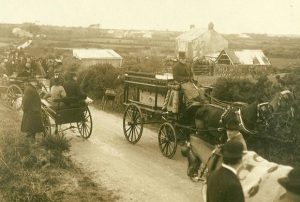 The funeral cortège leaving Seaview on its way to Mithian Church. (Photo: courtesy Clive Benney)
The funeral cortège leaving Seaview on its way to Mithian Church. (Photo: courtesy Clive Benney)
Many photographs exist showing various aspects of the murder. The press and police photographer was Mr Jordon of Truro and some of his press photographs were made into postcards as shown above. The Royal Cornwall Museum has a collection of Mr Jordon’s glass plate negatives showing more gruesome details and these were used at the inquest.
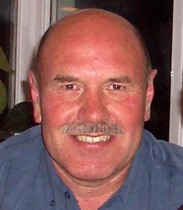 Clive Benney is a prolific researcher of Cornish history and an avid collector of St Agnes Parish postcards. He is the Vice-Chairman of St Agnes Museum Trust, the Recorder for St Agnes Old Cornwall Society, a Cornish Bard and the author of many books and articles.
Clive Benney is a prolific researcher of Cornish history and an avid collector of St Agnes Parish postcards. He is the Vice-Chairman of St Agnes Museum Trust, the Recorder for St Agnes Old Cornwall Society, a Cornish Bard and the author of many books and articles.
